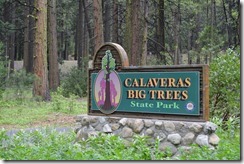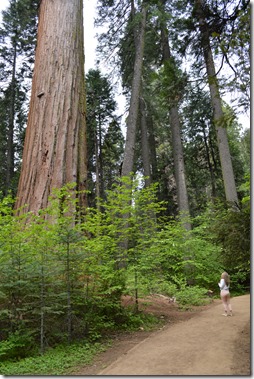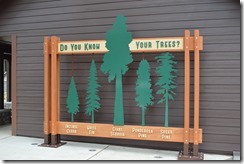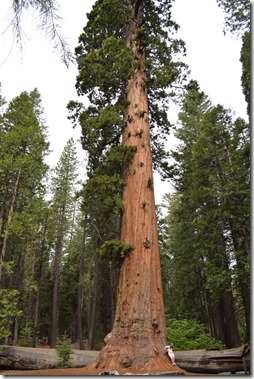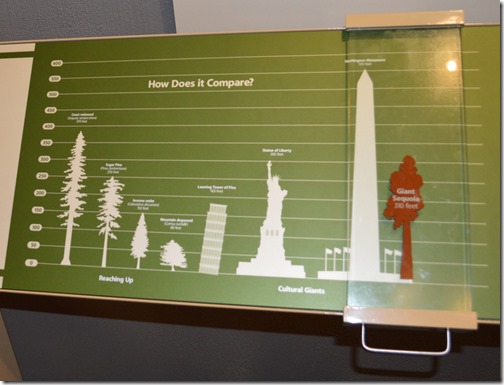Calaveras Big Trees State Park is considered California’s longest continuously operated tourist facility since 1853 when people starting visiting the Sierra foothills to see the Calaveras giant sequoia trees, the largest trees on Earth.
Calaveras Big Trees State Park
The Discovery Tree
Augustus T. Dowd made note of a large tree in the mid-Sierra mountain range he found in 1852. The giant tree measured 24 feet in diameter. ‘Discovery Tree’ was felled in 1853. It was determined to be 1,244 years old.
Discovery Tree Stump in Calaveras Big Trees State Park.
The stump and trunk of the Discovery Tree have been used in the past as a dance floor and bar.
The Discovery Tree went on tour when wood and bark were shipped to New York in 1854. Two floors of a hotel were rented to display the remnants of Discovery Tree in New York. The exhibit was a financial flop after being ridiculed by P.T. Barnum and press. The Discovery Tree exhibit burned before being displayed in Paris. There is a good history of these first tree exhibits in this piece on Big Trees as Trophies.
Have you seen the Giant Tree, the vegetable wonder of the world?
San Francisco 1853 exhibition handbill.
There are still about 100 giant Sequoia old trees in the North Gove of Calaveras Big Trees State Park and around 1,000 old growth trees in the South Grove.
Giant Sequoia trees, Sequoiadendron giganteum, can grow to about 310 feet high and 33 feet across in diameter at the base. Coast redwood trees grow taller, but have less overall wood volume.
Calaveras Big Trees State Park has a history of struggle between entrepreneurs and capitalists and conservationists since the giant sequoia trees were brought to public attention in 1852.
Build it and they will come
Joseph and Billie Lapham and A. Smith Hayes built a hotel near North Grove in 1856. People from around the world came to the hotel to visit the Big Trees. Love for these natural wonders led to a conservation movement, however, the North Grove of big trees was in private ownership.
Galen Clark, environment activist of the 1850s
There now seems to be no good reason why these Big Trees in California should become extinct for many centuries yet to come, if properly guarded and protected from the ruthless axes and saws of lumbermen. Californians as a mass have not yet fully realized the great value to the State of this magnificent endowment of Nature, one of her most precious crown jewels, which aids in attracting thousands of visitors and millions of dollars annually.
Galen Clark – 1907
Galen Clark was a Canadian who arrived in California in 1848. After developing tuberculosis, he moved to Wawona in Mariposa County, now part of Yosemite National Park and one of the park’s primary hotels Wawona Lodge. Galen Clark discovered the Mariposa Grove of giant sequoia trees in 1857 as the first non-native person to report on the grove with several hundred mature trees. Mariposa Grove has two of the 30 largest giant sequoia trees known.
Galen Clark was a leading activist lobbying for protection of the Mariposa Grove and Yosemite Valley. These are actually the first lands to be set aside for conservation in a park when Abraham Lincoln signed the Yosemite Grant, ceding the land to the state of California on June 30, 1864 to be preserved in a state park. This idea set precedence for the creation of Yellowstone National Park in 1872. Yosemite National Park was created in 1890 due to criticism over California’s lack of protection for the land. The park land was in court disputes for 16 years on the question of whether homesteaders could legally be evicted from designated park land. The Supreme Court of the U.S. ruled in favor of the government in 1880.
Creating Calaveras Big Trees State Park
Calaveras Big Trees State Park contains two groves of giant Sequoia trees in California. There are 68 listed groves of giant sequoia trees in California. Yosemite National Park has the Mariposa Grove and the largest tract of giant sequoia trees are found at Sequoia and Kings Canyon National Park to the south, east of Fresno and Bakersfield. General Sherman tree in Sequoia National park is the largest tree in the world with a diameter of 36.5 feet, 275 feet in height and an estimated age of 2,200 years.
Loyalty Traveler – On the Road to Earth’s largest tree in Sequoia National Park (Nov 3, 2013).
The Sperry family helped form the Calaveras Grove Association in 1926 to preserve the trees and Calaveras Big Trees State Park was created in 1931.
These are some of the most fascinating trees on the planet. I found the experience of standing beside the largest trees on the planet to be spiritual moments on the few trips I have taken to these big tree groves.
Calaveras Big Trees State Park
A detailed report on the early history of Calaveras Big Trees State Park is found in this Guardian newspaper Environment Blog – How a giant tree’s death sparked the conservation movement 160 years ago (June 27, 2013).
Last month I visited Cathedral Grove, a British Columbia park on Vancouver Island with old growth Douglas Fir trees as old as 800 years. The Guardian article contains a link to CathedralGrove.eu, a political and environmental website from Europe. There are photos of many of the largest trees on earth on this page “Big Trees as Trophies’, including stories of two Calaveras Big Trees with Discovery Tree and Mother of the Forest, which were world famous exhibits and attractions in the 1850s.
Ten Giant Sequoia Facts
1. A giant sequoia sees is about the size of an oatmeal flake.
2. A mature giant sequoia will produce about 1,500 to 2,000 new cones every year. Each cone holds around 100 seeds.
3. Since cones don’t drop every year, an average sequoia will have about 11,000 cones on it; one growing in ideal conditions can have as many as 40,000 cones.
4. Giant sequoia seeds are so light that there are approximately 90,000 of them in one pound.
5. Giant sequoias typically start producing seeds at 75 years of age and continue as long as they live.
6. A tree can produce 200,000 – 400,000 seeds in a year. That means there could be three billion seeds in the South Grove at any time.
7. Giant sequoias only grow naturally at elevations between 4,800 and 7,000 feet on the Western slope of the Sierra Nevada.
8. The largest Giant Sequoia in Calaveras Big Trees State Park is the Louis Agassiz tree, which is 250 feet tall and over 25 feet in diameter.
9. The oldest known giant sequoia was 3,200 years old.
10. Older giant sequoias have bark up to two feet thick at their bases, which helps proted them from ground fires.


